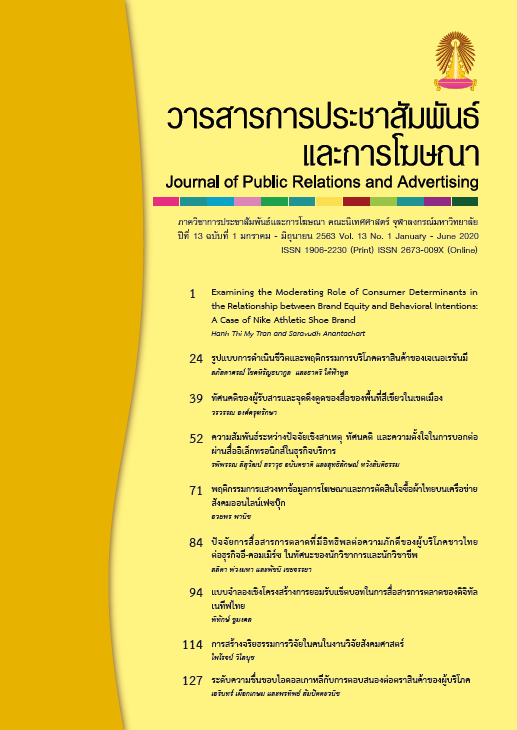A Structural Equation Model of Thai Digital Citizens’ Artificial Intelligence Adoption in Marketing Communication
Main Article Content
Abstract
This research is aimed to develop and validate a structural equation model towards the following objectives: (1) to explore Thai Digital Natives’ Lifestyles and their adoption of chat bot in marketing communication, (2) to develop a structural equation model for the adoption of chat bot in marketing communication of Thai Digital Natives, and (3) to test the congruence or the fit of the constructed structural equation model with the empirical evidence. The study is conducted by quantitative research using questionnaires in collecting data from 150 Thai Digital Natives aged 15-24 years old. Statistical analysis composes of descriptive statistics, factor analysis, and structural equation model. The findings are as follow:
1) From exploratory factor analysis, Lifestyles of Thai Digital Natives are classified into five groups: (1) digital addiction, (2) digital enthusiasm and versatility, (3) digital optimal literacy, (4) digital openness and flexibility, and (5) digital attachment with offline.
2) From Structural Equation Model, the developed model is congruent with empirical data by the acceptable criteria of eight congruence indices: Chi-Square/df = 1.913, RMR = .027, NFI = .877, IFI = .937, TLI = .923, CFI = .936, PNFI = .723, and RMSEA = .078. The developed model by the researcher is thus congruent with empirical data as specified in the hypothesis.
Article Details
References
กัลยา วานิชย์บัญชา. (2557). การวิเคราะห์สมการโครงสร้าง (SEM) ด้วย AMOS. กรุงเทพฯ : สามลดา.
กาญจนา แก้วเทพ. (2552). การวิเคราะห์สื่อ : แนวคิดและเทคนิค. กรุงเทพฯ : คณะนิเทศศาสตร์ จุฬาลงกรณ์มหาวิทยาลัย.
ชนัญญา เภกะนันทน์. (2560). รูปแบบการดำเนินชีวิต การเปิดรับสื่อ และการยอมรับนวัตกรรมของผู้บริโภคสูงอายุ. วารสารการประชาสัมพันธ์และการโฆษณา, 10(2): 15-30.
ชัย ฉายวิวัฒน์. (2554). รูปแบบการดำเนินชีวิต กับ การเปิดรับแอพพลิเคชันในเครือข่ายโทรศัพท์เคลื่อนที่ 3 จี ของเจนเนอเรชันวาย ที่ใช้โทรศัพท์เคลื่อนที่ในเขตกรุงเทพมหานคร . วิทยานิพนธ์บริหารธุรกิจมหาบัณฑิต สาขาบริหารธุรกิจมหาวิทยาลัยเกษตรศาสตร์.
ฐาวรา หวังสมบูรณ์ดี. (2553). ปัจจัยที่มีผลกระทบต่อการยอมรับอินเทอร์เนตแบงค์กิ้ง กรณีศึกษา พนักงานธนาคารยูโอบี สำนักงานใหญ่. การค้นคว้าอิสระปริญญามหาบัณฑิต สาขาการบริหารเทคโนโลยีมหาวิทยาลัยธรรมศาสตร์.
ณิศรา ศรีพลอยรุ่ง และปาริชาต สถาปิตานนท์. (2560). การใช้สื่อดิจิทัลด้านการท่องเที่ยวของกลุ่มดิจิทัลเนทีฟไทย. วารสารนิเทศศาสตร์, 35(3): 1-19.
ธนดล ยิ้มถนอม .(2557). การพัฒนาโมเดลเชิงสาเหตุของพฤติกรรมรับผิดชอบต่อสิ่งแวดล้อมของนักเรียนมัธยมศึกษาในกรุงเทพมหานคร. วารสารวิธีวิทยาการวิจัย. 27(1): 1-23.
บัญชา หมั่นกิจการ. (2560). แบบจำลองเชิงโครงสร้างของปัจจัยที่มีอิทธิพลต่อการยอมรับเทคโนโลยีระบบการชำระ เงินแบบอิเล็กทรอนิกส์ภาครัฐ (e-payment) ของผู้สูงอายุในเขตกรุงเทพมหานคร. วิทยานิพนธ์ศิลปศาสตรมหาบัณฑิต สาขานิเทศศาสตร์และนวัตกรรม สถาบันบัณฑิตพัฒนบริหารศาสตร์.
ปัณณวิช สนิทนราทร. (2560). ตัวแบบสมการโครงสร้างของตัวแปรที่มีอิทธิพลต่อความตั้งใจใช้บริการฟังเพลงแบบสตรีมมิ่งอย่างต่อเนื่องของผู้บริโภคในอุตสาหกรรมดนตรีของประเทศไทย. วิทยานิพนธ์ศิลปศาสตรมหาบัณฑิต สาขานิเทศศาสตร์และนวัตกรรม สถาบันบัณฑิตพัฒนบริหารศาสตร์.
พัชนี เชยจรรยา. (2559). Structural Equation Model of Thai Elderly’s Adoption of Communication Technology. วารสารนิเทศศาสตร์ปริทัศน์, 19(2): 85-100.
ยุทธ ไกยวรรณ์. (2556). การวิเคราะห์โมเดลสมการโครงสร้างด้วย AMOS. กรุงเทพฯ : สำนักพิมพ์แห่งจุฬาลงกรณ์มหาวิทยาลัย.
วิทยาลัยการจัดการ มหาวิทยาลัยมหิดล. (2562). ใครไม่ see... Gen Z - Gen Z Marketing. วันที่เข้าถึงข้อมูล 1 ตุลาคม 2562, แหล่งที่มา www.cm.mahidol.ac.th/cmmu/index.php/9-college-news/684-marketing-conference-29.
ศุภกร จูฑะพล. (2559). ทัศนคติ พฤติกรรม และความคล่องดิจิทัลของกลุ่มดิจิทัลเนทีฟ. วารสารวิชาการมนุษยศาสตร์และสังคมศาสตร์. 24(46) :313-329.
สพธอ. (2561). รายงานผลสำรวจพฤติกรรมผู้ใช้อินเทอร์เน็ตในประเทศไทย ปี 2561. กรุงเทพฯ: สำนักงานพัฒนาธุรกรรมทางอิเล็กทรอนิกส์ (องค์การมหาชน).
สังวรณ์ งัดกระโทก. (2557). โมเดลสมการโครงสร้างสำหรับการวิจัยทางสังคมศาสตร์. เอกสารประกอบการสอน. นนทบุรี: มหาวิทยาลัยสุโขทัยธรรมาธิราช.
สิทธิพันธ์ ทนันไชย. (2555). รูปแบบการดำเนินชีวิตที่ส่งผลต่อทัศนคติและกระบวนการตัดสินใจซื้อสินค้าเสมือน. วารสารการประชาสัมพันธ์และการโฆษณา, 5(1): 121-142.
สุมาลี มั่นแย้ม. (2560). ปัจจัยที่มีอิทธิพลต่อความตั้งใจใช้แอปพลิเคชันผู้ช่วยส่วนตัวกรณีศึกษา: แอปพลิเคชันสิริและกูเกิลแอสซิสแทนซ์. วิทยานิพนธ์วิทยาศาสตรมหาบัณฑิต สาขาวิชาระบบสารสนเทศเพื่อการจัดการ มหาวิทยาลัยธรรมศาสตร์.
ภาษาอังกฤษ
Bhattacherjee, A. (2011). Understanding Information Systems Continuance: An Expectation-Confirmation Model. MIS Quarterly, 25(3). 351-370.
Chawaporn Dhamanitayakul. (2019). Conceptualizing Digital Citizenship for Digital Natives in Thailand. Dissertations Doctor of Philosophy (Communication Arts and Innovation), National Institute of Development Administration. Bangkok.
Chuttur, M. Y. (2009). Overview of the technology acceptance model: Origins, developments and future directions. Working Papers on Information Systems, 9(37), 9-37.
Compeau, D., & Higgins, C. (1995). Computer self-efficacy: Development of a measure and initial test. MIS Quarterly. 19(2): 189-211.
Davis, F. (1985). A technology acceptance model for empirically testing new end-user informatation systems: theory an results. Unpublished Doctoral dissertation, MIT Sloan School of Management.
Davis, F. D., Bagozzi, R. P., & Warshaw, P. R. (1989). User acceptance of computer technology: A comparison of two theoretical models. Management Science, 35(8): 982–1003.
Fishbein and Ajzen. (1975). Belief Attitude Intention and Behavior: An Introduction to theory and Research. Mass: Addison-Wesley.
Hahn, H., & Puybaraud, M. (2012). Digital Natives: Born to be connected. [Power Point Research Report]. Retrieved from Research on Johnson Controls websites.
Moore, G., & Benbasat, I. (1991). Development of an instrument to measure the perceptions of adopting an information technology innovation. Information Systems Research, 192–222.
Plummer, J. T. (1974). The concept and application of lifestyle segmentation. Journal of Marketing, 38(1): 33–37.
Roger, Everett M. & Shoemaker, F. F. (1971). Communication of Innovation: A Cross-Cultural Approach. New York: The Free Press.
.


